![]()
![]()
![]()
 "In
their earliest form, dragons were associated with the Great Mother, the water
god and the warrior sun god. In these capacities they had the power to be both
beneficent and destructive and were all-powerful creatures in the universe.
Because of these qualities, dragons assumed the roles taken by Osiris and Set in
Egyptian mythology…
"In
their earliest form, dragons were associated with the Great Mother, the water
god and the warrior sun god. In these capacities they had the power to be both
beneficent and destructive and were all-powerful creatures in the universe.
Because of these qualities, dragons assumed the roles taken by Osiris and Set in
Egyptian mythology…
The significance of the dragon was its control over the destiny of mankind. As the myth developed in the western world, dragons came to represent the chaos of original matter with the result that with man's awakening conscience a struggle arose, and the created order constantly challenged the dragon's power. This type of dragon was considered by many to be the intermediate stage between a demon and the Devil and as such came into Christian belief. However, in the Eastern world the dragon adopted a rather different significance. He was essentially benevolent, son of heaven, and controlled the watery elements of the universe." (http://www.angelfire.com/va/drgon/history.html)
There are many types of creatures that have been labeled as 'dragons.' A number of researchers or simply lovers of the dragon have come up with various groups which describe each category of dragon. For example;
Serpent Dragons- Wingless, snakelike creatures associated with rivers, lakes or open seas, with "dragonesque heads, which often sport horns, and their long crocodilian jaws."
 Classical
Dragons- "The ferocious fire breathing, reptilian nemesis of countless
heroes from mythological and medieval times. This monstrous beast was encased in
an impenetrable armor of scintillating scales and borne upon four powerful limbs
with talon tipped feet. It wielded a long sweeping tail, terminating in an
arrow-headed sting; and often, but not invariably, sported a pair of huge,
batlike wings"
Classical
Dragons- "The ferocious fire breathing, reptilian nemesis of countless
heroes from mythological and medieval times. This monstrous beast was encased in
an impenetrable armor of scintillating scales and borne upon four powerful limbs
with talon tipped feet. It wielded a long sweeping tail, terminating in an
arrow-headed sting; and often, but not invariably, sported a pair of huge,
batlike wings"
Sky Dragons- Those that fly, having "forfeited terrestrial mastery or aquatic domination in favor of aerial supremacy"
Neo-Dragons- Not quite 'real' dragons, but "such pretenders as the basilisk, hydra, peluda, and other imitators are as dramatically dragonesque in behavior and appearance as any of their bona-fide brethren."
Semi-Dragons- "Lindorms and wyverns fall somewhere between dragons and serpents. The two-legged, wingless lindorms have greater affinities with serpents than with the classical dragons, while wyverns, which possess not only a pair of legs but also a pair of wings, are closer to the classical dragons." (http://www.oocities.org/Area51/1044/typesof.htm)
At http://www.angelfire.com/va/drgon/history.html, the grouping goes this way:
"The Amphitptere- A legless, winged serpent, it could be found along the banks of the Nile and in Arabia. It guarded frankincense-bearing trees and threatened all who would harvest the precious resin.
The Heraldic Dragon- The most widespread and formidable of it's kind. It had massive fangs, four clawed legs and a ridge of sharp spines that stretched from it's spiked nose to its barbed and stinging tail.
The Guivre- The legless and wingless guivre would have seemed a mere serpent albeit an immensely powerful one, except for its massive dragon head, horned and bearded. It likes to live in forests and wells - anywhere near water.
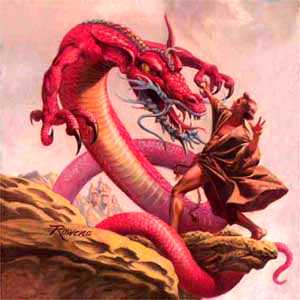 The
Wyvern- Feared for its viciousness and for the pestilence it brought to
northern Europe, Greece and Ethiopia, the wyvern had a coiling trunk that bore a
pair of eagle's legs, which were tucked beneath it's wings.
The
Wyvern- Feared for its viciousness and for the pestilence it brought to
northern Europe, Greece and Ethiopia, the wyvern had a coiling trunk that bore a
pair of eagle's legs, which were tucked beneath it's wings.
The Lindworm- Falling between the birdlike wyvern and the snakelike guivre, the lindworm had a serpentine body with one pair of legs. It was flightless. The Italian traveler Marco Polo reported seeing some lindworms while crossing the steppes of Central Asia. "
According to Dee (http://pages.bolt.com/other/dragonzgirl/dragon2.html);
"THE AMPITERE: A legless, winged, feathered serpent found along banks of the Nile, Mexico and in Arabia. Guardian of frankincense - bearing trees.
THE DRAKE: Legs, but no wings. Fire Drakes breathed fire and were a reddish color. Cold Drakes breathed snow and were a light blue color.
EASTERN DRAGON: Portrayed as kind and intelligent.
THE HERALDIC DRAGON: Most widespread and formidable of all kinds. Massive fangs, four clawed feet and a ridge of sharp spines on back from the tip of spiked nose to its barbed and stinging tail made it an immediate enemy.
THE GUIVRE: Legless and wingless it looked more like a serpent if it wasn't for the dragon head. Found anywhere near water.
THE LINDWORM: It had only one pair of legs and no wings. Lived in central Asia.
THE WYRM: Originated in England. Laired anywhere near water.
THE WYVERN: Found in northern Europe, Greece and Ethiopia. It had two eagle legs which it tucked beneath its wings."
The dragon that was slain by St. George was a heraldic dragon. Most British dragons are Worms (or Wyrms), much like the Scandinavian; they are wingless, long and self-joining. Both the worms and heraldic dragons "haunt wells or pools, both are avid for maidens and particularly priestesses, both are treasure-hoarders and are extremly hard to kill." (An Encyclopedia of Fairies by Katharine Briggs)
In my mind, I label dragons from where they originated. European dragons are the kinds most commonly seen in myths, looking like the heraldic, classical dragons that normally breath fire or steam. Then there are flying dragons and water-dwelling 'serpentine' ones, commonly found in mountains and lakes, respectively, of the Americas. In the east are the famous dragons and worms of Asia, elaborated by these following writings by Bruce W. McGee at http://www.bigwave.ca/~bmcgee/dragons.htm;
"Dragons have been an integral part of the culture of the Chinese, Koreans and Japanese peoples since the beginning of recorded history. In China they are used to mark the stairways over which only the Emperor could be carried. In Japan they are used in Buddhist temples both as decoration and as fountain heads for purification before worship. In many cases the dragon is combined with the phoenix to symbolize long life and prosperity. It is also combined with the tiger to represent heaven and earth or inyo (Yin and Yang)…
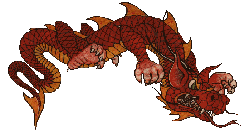 The
Chinese dragon has five toes. The Korean has four toes and the Japanese dragon
has three toes…
The
Chinese dragon has five toes. The Korean has four toes and the Japanese dragon
has three toes…
The dragon by nature is a gregarious creature who wanders the earth. However, the farther it goes from China, the more toes it loses. Hence, when it reached Korea it only had four toes and by the time it got to Japan it only had three. This also explains why it never made it to Europe or the Americas in that by the time it got that far it had lost all of its toes and could not walk…
[Asian dragons have no wings, but are often depicted coming down from the clouds or heavens and] the male dragon holds a war club in its tail while the female dragon holds a sensu or fan in its tail."
Chinese Dragons (http://www.angelfire.com/ri/eastern/tran.html):
"t'ien lung- celestial dragon, protector of the heavens
shen-lung- azure; spiritual dragon, bringer of rain
imperial dragon- five-toed; used by emperors to decorate their robes, usage by anyone else was punishable by death
ti-lung- dragon of land, streams, and rivers; spends springtime in heaven and autumn in the sea.
fu-ts'ang lung- treasure dragon; guards secret hoards of jewels and metals in the depths of the earth
yellow dragon or dragon horse- divine messenger; arose from the River Lo and revealed the 8 trigrams of I Ching
lung wang- human-bodied fire dragon; immortal dragon king; inhabits a palace at the bottom of the sea
thunder dragon- obsidian; transforms itself into a boy with bright ultramarine skin who rides a scarlet carp.
t'ao t'ieh- has one head and two forelegs, but has two bodies with separarte hind legs and tails; personifies gluttony; pictured on dishes to discourage greed; used commonly by artists because of its symmetry
yu lung- fish dragon; symbolizes success in exams "

"In the German town of Heidelberg, they say that once 'dragons were part of everyday life. Their eggs were commonly found in the river Neckar. People collected them, hatched and raised the dragons. The young dragons became loyal keepers and protectors of the house. Additionally they helped to light the hearth - remember, there were no matches at that time! Of course every blacksmith owned a dragon.
 People
living near the river Neckar, and especially fishermen preferred the
water-loving female dragons. Only male dragons were able to fly. They were
preferred by farmers and wine-growers. Old legends even tell about dragon-riders
- who knows? Female dragons were very inteelligent. There are reports, that some
of them were capable of the human language. They were beloved by wise women,
alchemists and sorcerers, and scholars, who often had philosophical discourses
with their dragons.
People
living near the river Neckar, and especially fishermen preferred the
water-loving female dragons. Only male dragons were able to fly. They were
preferred by farmers and wine-growers. Old legends even tell about dragon-riders
- who knows? Female dragons were very inteelligent. There are reports, that some
of them were capable of the human language. They were beloved by wise women,
alchemists and sorcerers, and scholars, who often had philosophical discourses
with their dragons.
 People
inhabiting only small rooms kept dwarf dragons. In this species both sexes had
wings. Their eggs were commonly found on the sunny hillsides in the vicinity of
Heidelberg.
People
inhabiting only small rooms kept dwarf dragons. In this species both sexes had
wings. Their eggs were commonly found on the sunny hillsides in the vicinity of
Heidelberg.
Christianity brought an end to these good old habits - the keeping of a domestic dragon. Clergymen interpreted dragons as an offspring of hell and prohibited any contact with these animals. Disobedience was rigorously punished.'" (http://members.tripod.com/~gfriebe/heidel.htm)
The death of a dragon is not something to be taken lightly. Many of the ancient legends are filled with tales of dragon slayers, most of which hold a highly Christian or Catholic bias. "Because the dragon was the natural enemy of man, his death became the ultimate goal, consequently there are innumerable battles between gods and dragons, saints and dragons, and in the medieval world, knights and dragons. In Egyptian mythology there is the conflict between Horus and Typhon, in Babylonia, the Chaldean Tiamat was overcome by Marduk. In Greek legends, the dragon fought on the side of the Titans and attacked Athene, who flung him into the heavens, where he became a constellation around the Pole Star. Hercules encountered, and killed the dragon Ladon while fulfilling his eleventh labor. In Scandinavian literature, Beowulf was slain by a dragon."
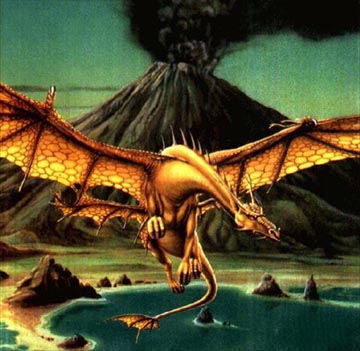 The
dragon, however, fears very little despite the multitudes of hazards set against
it. It's only true enemy is the elephant, "with whom he will engage in
battle, entwining himself around the elephant and inflicting fatal blows.
However, as the elephant finally collapses, his fall crushes the dragon to
death." (http://www.angelfire.com/va/drgon/history.html)
Elephants and dragons do eat the same kinds of food normally and both require
large amounts of it to survive, therefor this seems logical.
The
dragon, however, fears very little despite the multitudes of hazards set against
it. It's only true enemy is the elephant, "with whom he will engage in
battle, entwining himself around the elephant and inflicting fatal blows.
However, as the elephant finally collapses, his fall crushes the dragon to
death." (http://www.angelfire.com/va/drgon/history.html)
Elephants and dragons do eat the same kinds of food normally and both require
large amounts of it to survive, therefor this seems logical.
This following article is from http://www.angelfire.com/ak/forgottenworlds/home.html and contains what I believe is a wonderfully well-researched history of dragons in mythology, legend and lore.
"In A.D. 67 Roman Historian Octavus Livy wrote that he personally witnessed a battle between the eighth Roman Legion (led by General Scipio Regulus) and a great Heraldic Dragon in what is now Lybia and which lasted for almost a week. Over three thousand Roman soldiers were killed in the battle, which finally ended with the remaining Romans building siege engines and cornering and crushing it to death it in a canyon.
In the 1200's a Ukrainian historian named Byliny wrote of a small dragon which terrorized the steppes of western Russia for decades. The dragon was called Gorynych and was finally killed by a Ukrainian hunter named Dobrynja to avenge his brother's death. Note: this Dragon did not breathe fire.
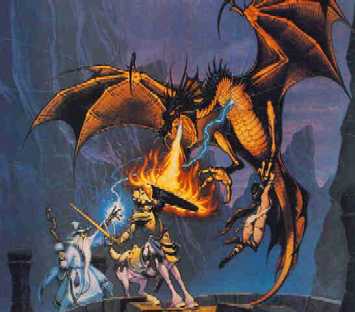 In
Historia Naturalis, written in 1701, it is recorded that a powerful Heraldic
Dragon was killed on Vatican hill in 1669 during a fight with the army of Rome.
This Dragon was reported to have had wings and webbed feet.
In
Historia Naturalis, written in 1701, it is recorded that a powerful Heraldic
Dragon was killed on Vatican hill in 1669 during a fight with the army of Rome.
This Dragon was reported to have had wings and webbed feet.
In 793 at the monastery of St. Cuthbert on the island of Lindisfarne off the West Coast of England, over a hundred monks claimed to have seen a flying dragon with black wings. Others joined it at sunset, and the monks said that the sky was eventually filled with them.
On the French Island of Marguerite a flying dragon was said to have killed over 3000 villagers and knights throughout the Middle Ages. It was dubbed Drac, and inhabited the Rhone River in France throughout the thirteenth century. It was infamous for the blood it shed. The French town of Draguignan was named after it. Most of Drac's attacks were aimed at the village of Beaucaire. Over a dozen armies went on campaigns after it but none were successful. The specific campaigns are recorded in the French and early Germanic histories: Ocino, Ragnarold, and Umberto of Guineve. The dragon is said to have eventually died of old age.
In the Cathedral of Canterbury a history records that on Friday, September 26, 1449, between the English towns of Suffolk and Essex there was a fight between a huge black dragon and a red, which was witnessed by an entire township and lasted for over an hour. In the end, the black was badly wounded and retreated to its lair. Two of the most respected Englishmen of the fifteenth century witnessed the fight: John Steel and Christopher Holder, and later confirmed the validity of the event.
In 1942 the German U-boat Reichland torpedoed a Norwegian trawler near the Scottish coast. The crew witnessed what they later recorded as a great sea serpent, over 60 feet long, breaching and swimming frantically away from the sinking ship.
In 1966 two British Paratroopers rowing across the Atlantic in a survival test were wakened.
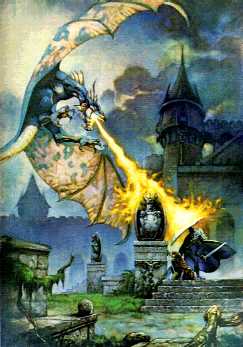 John
Ridgeway looked out from the boat and clearly saw a creature of enormous size,
like a serpent, poised over them with its head held high above the waves.
John
Ridgeway looked out from the boat and clearly saw a creature of enormous size,
like a serpent, poised over them with its head held high above the waves.
In Enuma Elish, a Mesopotamian creation epic written about 2000 BC, one of the central figures of the legend is the goddess Tiamat, a dragonlike personification of the oceans, who headed the hordes of chaos and whose destruction was prerequisite to an orderly universe. Marduk (the god of light) defeated Tiamat and Kingu, the dragons of chaos, and thereby gained supreme power.
Europe contained both beneficent and terror-inspiring dragons. In the Nibelungenlied, Siegfried kills a dragon, and one of the principal episodes of Beowulf deals with a similar achievement:
In episode three of Beowulf, the great hunter returns to his homeland, only to find it ravaged by a great Firedrake. He rallies his men to fight the creature but, when it comes into sight, all but Beowulf himself flee. In the end Beowulf kills the dragon, but in doing so the dragon sinks his mouth around Beowulf’s head and his life-blood gushed forth, ending the reign of the great Hero.
The basic pattern of the Leviathan myth recurs in the Greek story of the battle between Zeus and the many-headed dragon Typhon, recounted by Hesiod in the Theogony.
The mythological account of St. George and the Dragon is a treasured myth in Europe and is used to push the Catholic faith. (It is an analogy)
The ancient Norse mythological texts make constant reference to Ragnarok, the Dusk of the gods, the last battle between Good and Evil (note: this closely parallels the Biblical reference to Armageddon). As the story goes, at the end of time, The Great Midgard Serpent Jormungand, (note: also called Jormundgandr) the greatest of all Heraldic dragons, rose from the seas and made war upon the world. (linguistical note: Midgard is an old scandavinian word that means, strictly translated, middle-lands or middle-earth, Asgard is the old Norse word for the Heavens, which parallels the Welsh word, Aarda, which has the same meaning) All of Earth trembled before the great beast... All but Thor, the Nordic God of thunder (also note, Thor parallels the Hittite god of thunder, Tarku). He arose from his throne and descended from Asgard to make war upon the Serpent, until, with a final thunderous blow, Thor crushed the head of the beast and Jormungand died. It is then said that the god staggered back nine steps and, raising his hammer one last time he threw it down and buried it in the ground as a testament to his courage, succumbed to the Dragon's poison and died.
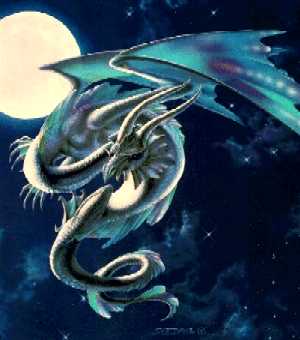 To
quote the New King James's Bible: Job 41:18-21 (refer to Job 1-17 and 21-34 for
a more detailed description) 18 By his (referring to Leviathan) neesings a light
doth shine, and his eyes are like the eyelids of the morning. 19 Out of his
mouth go burning lamps, and sparks of fire leap out. 20 Out of his nostrils
goeth smoke, as out of a seething pot or caldron. 21 His breath kindleth coals,
and a flame goeth out of his mouth. Psalms 104:25-26 25 So is this great and
wide sea, wherein are things creeping innumerable, both small and great beasts.
26 There go the ships: there is that leviathan, whom thou hast made to play
therein.
To
quote the New King James's Bible: Job 41:18-21 (refer to Job 1-17 and 21-34 for
a more detailed description) 18 By his (referring to Leviathan) neesings a light
doth shine, and his eyes are like the eyelids of the morning. 19 Out of his
mouth go burning lamps, and sparks of fire leap out. 20 Out of his nostrils
goeth smoke, as out of a seething pot or caldron. 21 His breath kindleth coals,
and a flame goeth out of his mouth. Psalms 104:25-26 25 So is this great and
wide sea, wherein are things creeping innumerable, both small and great beasts.
26 There go the ships: there is that leviathan, whom thou hast made to play
therein.
Isaiah 27:1 1 In that day the Lord with his sore and great and strong sword shall punish leviathan the piercing serpent, even leviathan that crooked serpent; and he shall slay the dragon that is in the sea. (note: this seems to parallel Ragnarok)
The ancient Norsemen adorned the prows of their vessels with carved likenesses of dragons.
Among the Celtic conquerors of Britain the dragon was a symbol of sovereignty. The legendary monster was also depicted on the shields of the Teutonic tribes that later invaded Britain, and it appeared on the battle standards of the English kings as late as the 16th century. Beginning in the early 20th century, it was inscribed on the armorial bearings of the Prince of Wales.
Bel and the Dragon, an addition to the Old Testament Book of Daniel in those versions of the Bible following the Greek Septuagint (generally Roman Catholic and Orthodox versions); included with the Apocrypha in the King James Version. It does not appear in the Hebrew Bible. Bel and the Dragon relates two legends about the prophet Daniel. The second of which tells of Daniel's miraculous delivery from a den of lions into which he had been thrown for killing a dragon revered by the Babylonians.
The name of the Amur River in Japan means Black Dragon.
Friar José de Santa Ritta Durão, belonging to the Minas Gerais school, wrote an epic called Caramurú (Sea Dragon) which celebrated the discovery of Bahia.
Cadmus, in Greek mythology, was a Phoenician prince who founded the city of Thebes in Greece. Near the site of the where he was to build Thebes, Cadmus and his companions found a sacred grove guarded by a dragon. After the beast killed his companions, Cadmus slew the dragon and, on the advice of the goddess Athena, planted its teeth in the ground. Cerberus, also in Greek mythology, was a three-headed, dragon-tailed dog that guarded the entrance to the lower world, or Hades.
Chimera, again in Greek mythology, was a fire-breathing monster that had the head of a lion, the body of a she-goat, and the tail of a dragon. It terrorized Lycia, a region in Asia Minor, but was finally killed by the Greek hero Bellerophon. Hesperides, yet again in Greek mythology, were the daughters of the Titan Atlas or of Night. Aided by a dragon, the Hesperides guarded a tree, with branches and leaves of gold, which bore golden apples. (some or all of these Greek references may be found in the epics: the Iliad and the Odyssey, both by Homer, or also in 'Jason and the Argonauts')"
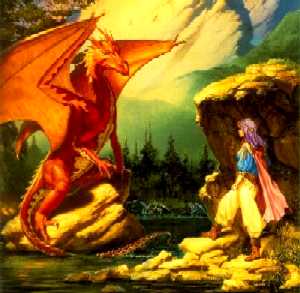 Dragons
mostly feed at night and avoid bright lights. The dragon's eyes are almost
color-blind, but excellent during the night. Not at day. They become dazzled and
are unable to respond effectively when near bright lights or sunlight. They have
a 'third eye' to help them know when the light was getting to be too bright. In
the past, that translucent, round eye was believed to be a jewel, and so the
dragon population was hunted.
Dragons
mostly feed at night and avoid bright lights. The dragon's eyes are almost
color-blind, but excellent during the night. Not at day. They become dazzled and
are unable to respond effectively when near bright lights or sunlight. They have
a 'third eye' to help them know when the light was getting to be too bright. In
the past, that translucent, round eye was believed to be a jewel, and so the
dragon population was hunted.
Not all of the types of dragons can produce fire. All of them can, though, emit a mixture of gas and water vapor that resemble clouds of mist. Only the European flightless dragons have evolved means of igniting this vapor into an effective fire-breathing method of defense. This may be perhaps by grinding their teeth together and creating a spark. Of course, no one has gotten close enough to inspect this process so no one can be perfectly certain.
![]()